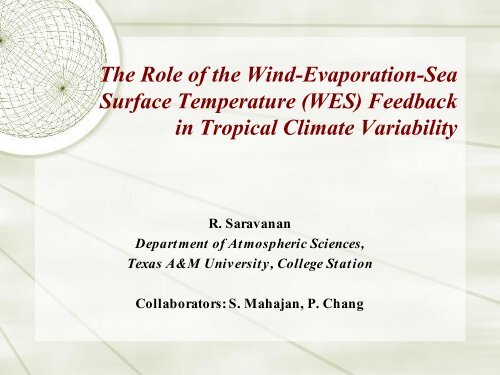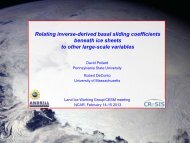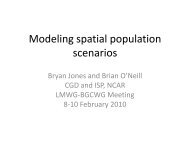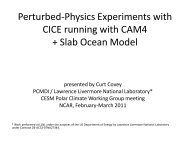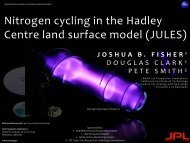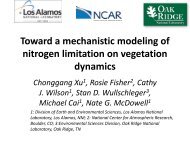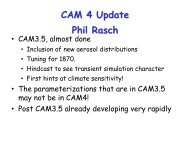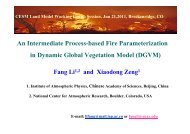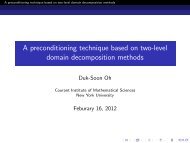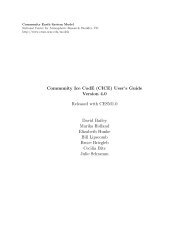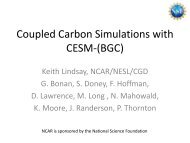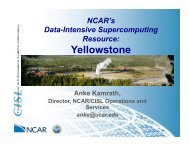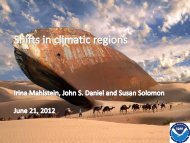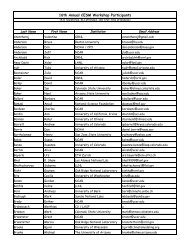The role of wind-evaporation-SST feedback in tropical variability
The role of wind-evaporation-SST feedback in tropical variability
The role of wind-evaporation-SST feedback in tropical variability
Create successful ePaper yourself
Turn your PDF publications into a flip-book with our unique Google optimized e-Paper software.
<strong>The</strong> Role <strong>of</strong> the W<strong>in</strong>d-Evaporation-Sea<br />
Surface Temperature (WES) Feedback<br />
<strong>in</strong> Tropical Climate Variability<br />
R. Saravanan<br />
Department <strong>of</strong> Atmospheric Sciences,<br />
Texas A&M University, College Station<br />
Collaborators: S. Mahajan, P. Chang
W<strong>in</strong>d Evaporation <strong>SST</strong> (WES) Feedback<br />
L<br />
H<br />
+<br />
-<br />
+<br />
06-19-2008 CCSM Workshop 2008<br />
T<br />
T<br />
-<br />
Equator<br />
<strong>SST</strong><br />
+<br />
WIND<br />
EVAPORATION<br />
Positive Feedback
Role <strong>of</strong> WES Feedback<br />
<strong>The</strong> WES <strong>feedback</strong> is featured <strong>in</strong> several<br />
hypotheses to expla<strong>in</strong> the <strong>tropical</strong> mean<br />
climate and <strong>variability</strong><br />
Asymmetric ITCZ about the equator (Xie, 2004)<br />
Westward seasonal propagation <strong>of</strong> equatorial <strong>SST</strong> anomalies<br />
(Xie, 1994)<br />
Tropical Atlantic <strong>variability</strong> (“ Atlantic dipole”) (Chang et al.,<br />
1997)<br />
Equatorward propagation <strong>of</strong> high-latitude cool<strong>in</strong>g (Chiang and<br />
Bitz, 2005)<br />
06-19-2008 CCSM Workshop 2008
In previous studies, the <strong>role</strong> <strong>of</strong> the WES<br />
<strong>feedback</strong> has usually been <strong>in</strong>ferred from<br />
statistical analysis or us<strong>in</strong>g simple analytical<br />
models.<br />
Our approach: direct mechanistic tests<br />
06-19-2008 CCSM Workshop 2008
Mechanistic Experiments<br />
<strong>SST</strong><br />
CCM3-SOM:<br />
+<br />
T42 Spectral Resolution (2.8 x 2.8)<br />
18 vertical levels<br />
SOM: spatially vary<strong>in</strong>g mixed layer depth but<br />
constant <strong>in</strong> time<br />
Prescribed sea-ice<br />
Q-flux adjustment<br />
WIND<br />
EVAPORATION<br />
06-19-2008 CCSM Workshop 2008<br />
<strong>SST</strong><br />
WIND<br />
+ EVAPORATION<br />
Control Run WES <strong>of</strong>f Run
Heat Flux Bulk Formulations:<br />
LH Flux = u*(q s- q*)B<br />
SH Flux = u*(T s-T*)D<br />
Experimental Set-up<br />
<strong>SST</strong><br />
u* = reference height w <strong>in</strong>d speed<br />
q* = specific humidity at reference height<br />
qs = specific humidity at surface<br />
T* = Temperature at reference height<br />
Ts = Temperature at surface<br />
B, D: Bulk Coefficients<br />
WES <strong>of</strong>f: Prescribe u* while comput<strong>in</strong>g Fluxes<br />
06-19-2008 CCSM Workshop 2008<br />
+<br />
WIND<br />
EVAPORATION
Experimental Set-up<br />
Experiment Set 1: To understand the <strong>variability</strong><br />
associated with WES <strong>feedback</strong><br />
Control Run: 80 years<br />
WES-<strong>of</strong>f-SOM Run: 80 years<br />
Experiment Set 2: To study the Equatorial<br />
Annual Cycle<br />
WES-<strong>of</strong>f-NoANN Run: 40 years<br />
• u* prescribed as annual mean, no seasonal cycle<br />
06-19-2008 CCSM Workshop 2008
(K 2 )<br />
(mm/day) 2<br />
WES Feedback and <strong>SST</strong><br />
06-19-2008 CCSM Workshop 2008<br />
Variability<br />
Spr<strong>in</strong>g Season<br />
% Change <strong>in</strong> <strong>SST</strong> variance : Control run - WES <strong>of</strong>f ANN Run<br />
% Change
Tropical Atlantic Variability<br />
06-19-2008 CCSM Workshop 2008<br />
WES-<strong>of</strong>f-SOM<br />
CCM3-SOM
WES Feedback and <strong>SST</strong><br />
Anomaly Propagation<br />
Strong seasonal cycle <strong>in</strong> the E.Pacific because <strong>of</strong> shallow mixed<br />
layer<br />
<strong>SST</strong> anomalies propagate westward<br />
Control Run<br />
<strong>SST</strong> Anomaly<br />
Longitude Longitude<br />
06-19-2008 CCSM Workshop 2008
Annual Cycle <strong>of</strong> <strong>SST</strong> and LHFLX<br />
<strong>SST</strong><br />
Equatorial Pacific<br />
(2S-2N)<br />
LHFLX<br />
06-19-2008 Control CCSM Run Workshop 2008<br />
WES-<strong>of</strong>f-SOM Run
Equatorward propagation<br />
QuickTime and a<br />
TIFF (Uncompressed) decompressor<br />
are needed to see this picture.<br />
06-19-2008 CCSM Workshop 2008<br />
<strong>of</strong> cold anomalies<br />
Chiang and Bitz (2005)<br />
Last Glacial Maximum<br />
(LGM) sea-ice anomalies<br />
Drier and colder higher and<br />
mid-latitudes<br />
Increased easterlies lead to<br />
evaporative cool<strong>in</strong>g<br />
WES Feedback: <strong>SST</strong> front<br />
moves southwards and<br />
moves ITCZ southwards<br />
Changes <strong>in</strong> surface temperature and precipitation as<br />
compared to a control run.
Experiment Set 4:<br />
06-19-2008 CCSM Workshop 2008<br />
Experimental Set-up:<br />
Tropical Response to High<br />
Sea-ice extent January:<br />
Current conditions<br />
Prescribe Last Glacial<br />
Maximum (LGM) sea-ice<br />
anomalies <strong>in</strong> the Northern<br />
Hemisphere:<br />
• Control Run: CCM3-SOM-<br />
SICE<br />
• WES-<strong>of</strong>f Run: WES-<strong>of</strong>f-SICE<br />
Sea-ice extent January:<br />
CCM3-SOM-SICE/ LGM<br />
Latitude Cool<strong>in</strong>g
Surface Temperature Response<br />
to High Latitude Cool<strong>in</strong>g<br />
Control Case WES-<strong>of</strong>f Case<br />
06-19-2008 CCSM Workshop 2008
Tropical Response to<br />
High Latitude Cool<strong>in</strong>g<br />
Control Case WES-<strong>of</strong>f Case<br />
06-19-2008 CCSM Workshop 2008
06-19-2008 CCSM Workshop 2008<br />
SUMMARY<br />
Even though it is a boundary layer phenomenon, WES<br />
<strong>feedback</strong> can produce non-local (cross-equatorial) atmospheric<br />
response to <strong>SST</strong> anomalies<br />
Responsible for a significant portion <strong>of</strong> <strong>tropical</strong> Atlantic<br />
<strong>variability</strong>, and a smaller portion <strong>of</strong> <strong>tropical</strong> Pacific <strong>variability</strong><br />
Controls the westward propagation <strong>of</strong> annual cycle <strong>of</strong><br />
equatorial <strong>SST</strong><br />
Plays a <strong>role</strong> <strong>in</strong> shift<strong>in</strong>g ITCZ under LGM sea-ice conditions,<br />
but less so than orig<strong>in</strong>ally proposed<br />
In addition to surface <strong>w<strong>in</strong>d</strong>speed, near surface humidity is<br />
also a very important factor <strong>in</strong> controll<strong>in</strong>g <strong>tropical</strong> <strong>variability</strong>.
06-19-2008 CCSM Workshop 2008<br />
Introduction: WES<br />
<strong>The</strong>rmodynamic air-sea coupl<strong>in</strong>g<br />
Feedback<br />
Weaker than dynamic coupl<strong>in</strong>g (Bjerknes<br />
<strong>feedback</strong>)<br />
Boundary layer phenomenon<br />
Non-local effects
Spr<strong>in</strong>g Season<br />
WES Feedback and ITCZ<br />
Ra<strong>in</strong>fall: Control Run - WES <strong>of</strong>f ANN Run<br />
Ra<strong>in</strong>fall (mm/day)<br />
06-19-2008 CCSM Workshop 2008
Spr<strong>in</strong>g Season<br />
CCM3 Runs: Mean State<br />
LH Flux: Control Run - WES <strong>of</strong>f ANN Run<br />
LH Flux (W/m 2 )<br />
06-19-2008 CCSM Workshop 2008<br />
(W/m 2 )
Equatorial Annual Cycle<br />
Seasonal Cycle <strong>of</strong> zonal<br />
<strong>w<strong>in</strong>d</strong>s (U) over Equatorial<br />
Pacific (2S-2N) for<br />
Control Run and the<br />
WES-<strong>of</strong>f-Run<br />
Control Run WES-<strong>of</strong>f-SOM Run<br />
06-19-2008 CCSM Workshop 2008
Seasonal Cycle <strong>of</strong> <strong>SST</strong>,<br />
q over Equatorial<br />
Pacific (2S-2N) for<br />
Control Run and the<br />
WES-<strong>of</strong>f-Run<br />
Equatorial Annual Cycle<br />
Control Run<br />
06-19-2008 CCSM Workshop 2008<br />
WES-<strong>of</strong>f-SOM Run
Atlantic Meridional Mode<br />
Coupled Mode Variability:<br />
• SVD pattern <strong>of</strong> <strong>SST</strong> (color) and LHFLX (contours) for<br />
Control Run and the WES-<strong>of</strong>f-Run.<br />
• Regression <strong>of</strong> surface <strong>w<strong>in</strong>d</strong>s on first PC <strong>of</strong> <strong>SST</strong><br />
06-19-2008 CCSM Workshop 2008
1. ITCZ Asymmetry:<br />
Introduction: Roles<br />
Equatorial Ocean upwell<strong>in</strong>g (Xie and Philander, 1994)<br />
North-west alignment <strong>of</strong> Americas and north-west<br />
African bulge (Philander et al. 1996)<br />
Stratus cloud-<strong>SST</strong> <strong>feedback</strong> (Philander et al., 1996)<br />
WES <strong>feedback</strong> (Xie, 1996)<br />
Annual Mean Climatological <strong>SST</strong> and Ra<strong>in</strong>fall<br />
(Source: Xie 2005)<br />
06-19-2008 CCSM Workshop 2008<br />
<strong>of</strong> WES Feedback<br />
Time-Latitude section <strong>of</strong><br />
<strong>SST</strong>, <strong>w<strong>in</strong>d</strong>s and precipitation<br />
over the eastern Pacific and<br />
Atlantic (Source: Xie 2005)
Annual Mean Climatology: <strong>SST</strong> (Reynolds and<br />
Smith), precipitation (CMAP) and <strong>w<strong>in</strong>d</strong>s (SODA)<br />
(Wang et al., 2004)<br />
Introduction: Roles <strong>of</strong><br />
06-19-2008 CCSM Workshop 2008 W<br />
the WES Feedback<br />
2. Equatorial Annual Cycle:<br />
Westward Propagation<br />
Ocean Temperature: TOGA-TAO moor<strong>in</strong>g data at<br />
the equator and 110 W (Xie, 1994)<br />
H<br />
H<br />
+<br />
Equatorial Section Schematic<br />
L<br />
+<br />
L<br />
+<br />
E
PC analysis<br />
(Ruiz-Barrados<br />
et al., 2000)<br />
Introduction: Roles <strong>of</strong><br />
3. Atlantic Meridional Mode<br />
06-19-2008 CCSM Workshop 2008<br />
the WES Feedback<br />
Dipole Mode: Regression <strong>of</strong> dipole <strong>in</strong>dex<br />
onto <strong>SST</strong> for a RGO coupled to an empirical<br />
atmospheric model with no dynamic<br />
<strong>feedback</strong> but allow<strong>in</strong>g for thermodynamic<br />
<strong>feedback</strong> (Chang et al., 1997)
Introduction: Roles <strong>of</strong><br />
4. Atlantic response to ENSO<br />
06-19-2008 CCSM Workshop 2008<br />
the WES Feedback<br />
Large scale<br />
impacts <strong>of</strong> ENSO<br />
on vertical<br />
motions (Kle<strong>in</strong> et<br />
al., 1999)<br />
Correlation<br />
between<br />
Atlantic <strong>SST</strong><br />
and N<strong>in</strong>o3<br />
<strong>in</strong>dex <strong>in</strong><br />
spr<strong>in</strong>g<br />
(Saravanan<br />
and Chang,<br />
2000)<br />
Correlation between ENSO <strong>in</strong>dex and<br />
upper tropospheric humidity, cloud cover<br />
(ISCCP) and <strong>in</strong>solation (ERBE) (Kle<strong>in</strong> et<br />
al., 1999)
Traditional Approach:<br />
06-19-2008 CCSM Workshop 2008<br />
WES Feedback<br />
Stand-alone AGCM or OGCM<br />
Coupled Model<br />
• Enhanced <strong>variability</strong> <strong>of</strong> the coupled model<br />
<strong>in</strong>dicates <strong>feedback</strong> mechanisms.<br />
Our Approach: WES-<strong>of</strong>f-Experiments:<br />
CCM3 coupled to a Slab Ocean Model (SOM)<br />
Switch <strong>of</strong>f the WES <strong>feedback</strong><br />
Comparison would reveal its <strong>role</strong>
Change <strong>in</strong> the <strong>variability</strong><br />
<strong>of</strong> Latent Heat Flux, <strong>SST</strong><br />
for the spr<strong>in</strong>g season<br />
between a Control Run<br />
and the WES-<strong>of</strong>f-Run<br />
06-19-2008 CCSM Workshop 2008<br />
WES Variability
Change <strong>in</strong> the <strong>variability</strong><br />
<strong>of</strong> Precipitation, Surface<br />
W<strong>in</strong>ds for the spr<strong>in</strong>g<br />
season between a<br />
Control Run and the<br />
WES-<strong>of</strong>f-Run<br />
06-19-2008 CCSM Workshop 2008<br />
WES Variability
WES: Tropical Response<br />
to High Latitude Cool<strong>in</strong>g<br />
06-19-2008 CCSM Workshop 2008
WES: Tropical Response<br />
to High Latitude Cool<strong>in</strong>g<br />
06-19-2008 CCSM Workshop 2008
WES: Tropical Response<br />
to High Latitude Cool<strong>in</strong>g<br />
06-19-2008 CCSM Workshop 2008
WES: Tropical Response<br />
to High Latitude Cool<strong>in</strong>g<br />
06-19-2008 CCSM Workshop 2008
Experimental Set-up:<br />
Experiment Set 3:<br />
06-19-2008 CCSM Workshop 2008<br />
ENSO<br />
Forced ENSO <strong>variability</strong> over the Atlantic:<br />
• Artificial 4 year ENSO <strong>SST</strong> cycle prescribed<br />
over Tropical Pacific<br />
• EOF pattern from observations<br />
• Multiplied with a cos<strong>in</strong>e function:<br />
• Time period: 4 years<br />
• Amplitude: 1 <strong>of</strong> N<strong>in</strong>o 3 <strong>in</strong>dex<br />
• ENSO forced control run: CCM3-SOM-ENSO<br />
• ENSO forced WES-<strong>of</strong>f run: WES-<strong>of</strong>f-ENSO
WES: Atlantic Response<br />
ENSO Response: Coupled Mode Variability:<br />
• SVD pattern <strong>of</strong> <strong>SST</strong> (color) and LHFLX (contours) for<br />
CCM3-SOM-ENSO and the WES-<strong>of</strong>f-ENSO.<br />
• Regression <strong>of</strong> surface <strong>w<strong>in</strong>d</strong>s on first PC <strong>of</strong> <strong>SST</strong><br />
06-19-2008 CCSM Workshop 2008<br />
to ENSO
WES: Tropical Response<br />
to High Latitude Cool<strong>in</strong>g<br />
06-19-2008 CCSM Workshop 2008
WES: Atlantic Response<br />
Atlantic Response to ENSO:<br />
06-19-2008 CCSM Workshop 2008<br />
to ENSO<br />
• Regression <strong>of</strong> April-May-June <strong>SST</strong>(K) and January-Feb-<br />
March net surface heat flux (W/m 2 ) on January ENSO <strong>in</strong>dex<br />
for CCM3-SOM-ENSO
WES: Atlantic Response<br />
Atlantic Response to ENSO:<br />
• Partition<strong>in</strong>g <strong>of</strong> January-Feb-March<br />
net surface heat flux (W/m 2 )<br />
• Regression <strong>of</strong> LHFLX and SHFLX<br />
on January ENSO <strong>in</strong>dex for CCM3-<br />
SOM-ENSO<br />
06-19-2008 CCSM Workshop 2008<br />
to ENSO
WES: Atlantic Response<br />
Partition<strong>in</strong>g LHFLX:<br />
• LHFLX = - (u*q) L vap<br />
• LHFLX’ = - (u*’ + q’) L vap<br />
06-19-2008 CCSM Workshop 2008<br />
to ENSO
WES: Atlantic Response<br />
Role <strong>of</strong> the WES Feedback:<br />
• Reduced <strong>SST</strong> response <strong>in</strong> the WES<strong>of</strong>f-SOM<br />
run<br />
06-19-2008 CCSM Workshop 2008<br />
to ENSO<br />
CCM3-SOM-ENSO WES-<strong>of</strong>f-ENSO
WES: Atlantic Response<br />
Role <strong>of</strong> the WES Feedback:<br />
• Amplification <strong>of</strong> <strong>w<strong>in</strong>d</strong> response <strong>in</strong> the<br />
presence <strong>of</strong> WES <strong>feedback</strong><br />
06-19-2008 CCSM Workshop 2008<br />
to ENSO<br />
CCM3-SOM-ENSO WES-<strong>of</strong>f-ENSO
WES: Atlantic Response<br />
Role <strong>of</strong> the WES Feedback:<br />
• Regression <strong>of</strong> April-May-June surface specific<br />
humidity on the ENSO January <strong>in</strong>dex for CCM3-SOM-<br />
ENSO and WES-<strong>of</strong>f-ENSO runs.<br />
• Less cross-equatorial transport <strong>of</strong> moisture <strong>in</strong> the<br />
absence <strong>of</strong> WES <strong>feedback</strong><br />
06-19-2008 CCSM Workshop 2008<br />
to ENSO<br />
CCM3-SOM-ENSO WES-<strong>of</strong>f-ENSO
WES: Atlantic Response<br />
Role <strong>of</strong> the WES Feedback: ITCZ response<br />
06-19-2008 CCSM Workshop 2008<br />
to ENSO<br />
• Regression <strong>of</strong> April-May-June precipitation on the ENSO January <strong>in</strong>dex<br />
for CCM3-SOM-ENSO and WES-<strong>of</strong>f-ENSO runs.<br />
• Subsidence dur<strong>in</strong>g El-N<strong>in</strong>o events<br />
• Northward movement <strong>of</strong> the ITCZ dur<strong>in</strong>g El-N<strong>in</strong>o events only <strong>in</strong> the<br />
presence <strong>of</strong> WES <strong>feedback</strong><br />
CCM3-SOM-ENSO WES-<strong>of</strong>f-ENSO


